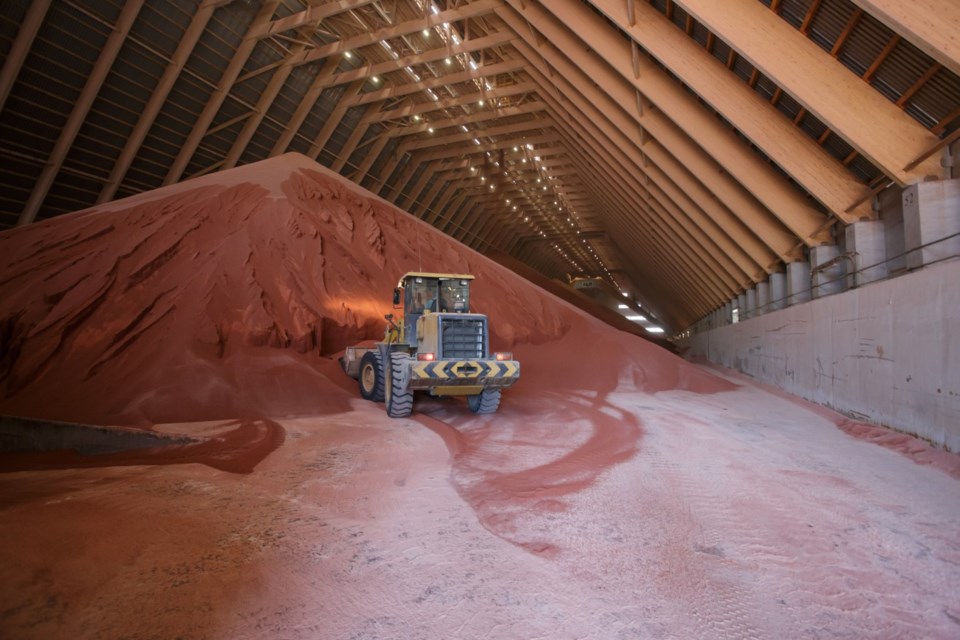WESTERN PRODUCER — The man who leads the world’s largest supplier of crop nutrients says there’s no quick relief in sight for tight global supplies of nitrogen and potash.
During a presentation at the Food, Fuel and Fertilizer Business Summit held in Saskatoon Feb. 14-15, Nutrien president and chief executive officer Ken Seitz said the ongoing military conflict in Ukraine will continue to limit global supplies of critical farm inputs.
Global demand for nitrogen and potash is expected to remain strong as farmers in major food exporting nations focus on maximizing yields to make up for declining agricultural output in Ukraine, he added.
In a nutshell, all signals point to a positive business outlook for Nutrien, which recently announced plans to boost potash production in Saskatchewan to 18 million tonnes annually by 2026, up from 13 million tonnes in 2021.
“Geopolitical events caused an unprecedented level of supply disruption and market volatility across agriculture, energy and fertilizer markets in 2022,” Seitz said, following the release of Nutrien’s fourth quarter and full-year 2022 financial results.
“The outlook for our business is strong as we expect global supply issues to persist and demand for crop inputs to increase in 2023.”
At the FFFBS event, Seitz said the world was dealing with a significant food insecurity problem even before the Russian invasion of Ukraine.
In 2021, about 800 million people worldwide were going to bed hungry each day, he added.
“Those (food insecurity) challenges were pretty substantive, even prior to this conflict in Eastern Europe, and now, of course, with one breadbasket of the world in conflict… certainly the logistics associated with getting grains and oilseeds out of that region has caused greater food insecurity.”
Seitz said global grain stocks-to-use ratios recently fell to 25-year lows, a situation that could take years to normalize.
As a result, farmers in other major food-producing and exporting nations, including Canada, are focused on maximizing yields and filling the global food supply gap.
“Global grain inventories have been depleted… and we think it’s going to take multiple cropping cycles to replenish those inventories,” he said, noting a strong outlook for ag fundamentals.
“We expect the backdrop for agricultural commodities, compared to historical averages, to be quite strong. In other words, the farmer is going to have the proper incentives to lay down the appropriate crop nutrients to maximize yields.”
On global fertilizer supplies, Seitz said supply challenges are likely to continue for the foreseeable future.
Even before the conflict in Ukraine, global fertilizer demand was growing at an annual rate of two to 2.5 percent, he told the audience.
That was before fertilizer supplies from Belarus and Russia were disrupted by economic sanctions, restricted access to tidewater ports and the loss of access to capital and machinery needed to sustain Russian mining operations.
Before the conflict in Ukraine, about 40 percent of the world’s traded potash came from Belarus and Russia.
In 2022, Belarus potash exports fell to about 50 percent of their pre-war levels and Russian production is estimated to have dropped to about one-third below 2021 levels.
“Those are huge numbers,” Seitz said.
“We don’t expect to see a return to normal volumes in Russia… (and) we don’t expect to see a recovery in Belorussian volumes in potash.”
“In addition, about 60 percent of the world’s new supply (of potash) over the next five years was supposed to be coming from Russia and Belarus, so we think that those (developments) too will be challenged, or at minimum delayed, because there’s no market for those (Russian and Belorussian) products.”
Global nitrogen supplies will also continue to be restricted because of European reliance on Russian natural gas, Seitz suggested.
Natural gas is a primary ingredient in nitrogen fertilizer production and before the war in Ukraine, European manufacturers produced about 20 percent of the world’s nitrogen fertilizer supplies.
“Being beholden to Russian (natural gas) supplies, we see that those nitrogen plants in Europe are very challenged to run…,” Seitz said.
“About one-third of them are shut down today.”
Seitz said Nutrien is ramping up production to meet the demands of farmers in key exporting nations including Canada, the United States, Australia and Brazil.
At the same time, the company must reduce its carbon footprint and decarbonize the nitrogen complex, he said.
Partnerships with farmers will play an important role in helping the company to reach those objectives, Seitz added.
In an interview with The Western Producer, he cited a Nutrien pilot project that will enable growers to create and monetize “high quality carbon credits” or offsets.
So far, about 800,000 acres are registered through the project in Canada and the U.S.
Seitz said that as “nascent carbon markets develop,” farmers could one-day realize revenues as high as $20 per tonne of C02 equivalent.
The development and sale of “carbon assets” would presumably hinge on the emergence of dependable offset markets, the widespread adoption of soil sampling to establish on-farm carbon baselines, the use of preferred farming practices and increased reliance on polymer-coated, slow-release fertility products.
Applied injudiciously, mandated nitrogen caps will negatively affect food production, Seitz added.
“Without enough nitrogen, you’re going to reduce yields on this planet,” he said.
“There’s going to be additional food security challenges.”
That said, environmental sustainability goals can be achieved without negatively affecting overall food production, he added.
“We believe that there’s a path forward here to improving yields while at the same time improving those sustainability outcomes.”




